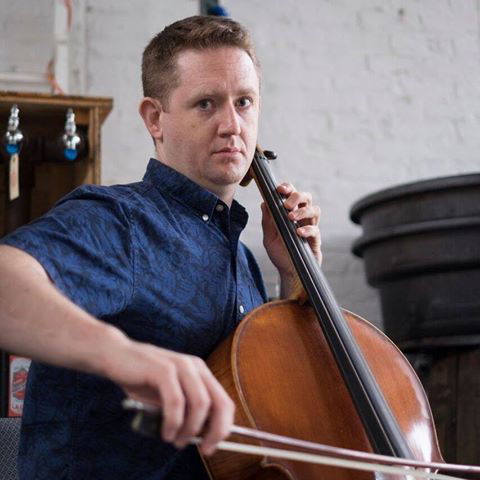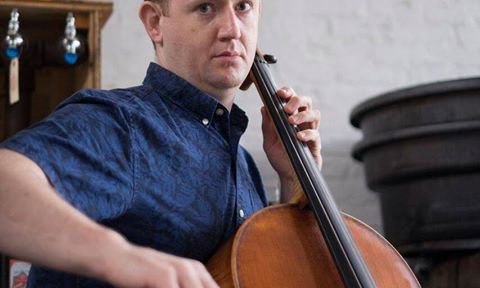Cellimba Duo! Cello + Marimba
Details
Peter Kibbe full profile / Cello + Marimba / 2 musicians
Other players: Nonoka Mizukami
Full program notes
This concert program explores a vivid cross-section of 20th-century and contemporary classical music, reimagined for the unique and intimate pairing of cello and marimba. With works spanning four diverse composers—György Ligeti, Toru Takemitsu, Alberto Ginastera, and Pietro Mascagni—the evening invites the audience into a kaleidoscope of textures, rhythms, and emotional colors, all filtered through the warm resonance of this unconventional duo.
The program opens with a selection from György Ligeti’s Musica Ricercata, a monumental cycle originally written for solo piano. In this transcription for cello and marimba, the individual character of each movement is brought into sharp relief. Beginning with the somber and austere Sostenuto, the set journeys through moments of playful energy (Allegro con spirito), jagged caprice (Allegro molto capriccioso), lyrical introspection (Cantabile molto legato), and percussive vivacity (Vivace energico, Vivace capriccioso). Ligeti's deep exploration of intervallic constraints and evolving rhythmic complexity is given new shape through the coloristic interplay between the marimba’s wooden timbre and the cello’s expressive range.
Next is Toru Takemitsu’s Towards the Sea, a meditative work originally written for alto flute and guitar. This arrangement of its second and third movements, Moby Dick and Cape Cod, is perfectly suited to the timbral sensitivity of marimba and cello. Takemitsu was deeply influenced by both nature and literature, and in these movements, one can hear the undulating currents and poetic stillness of the sea. The music unfolds with gentle ambiguity, favoring suggestion over declaration, and invites listeners into a state of quiet contemplation.
Alberto Ginastera’s Pampeana No. 2 follows, drawing inspiration from the musical traditions of the Argentine pampas. Originally written for cello and piano, this rhapsodic and virtuosic piece adapts naturally to the percussive richness of the marimba. Ginastera’s blend of folkloric elements with modernist language results in a fiery and dynamic sound world, marked by rhythmic propulsion, sweeping melodic gestures, and passionate outbursts. The cello acts as both singer and storyteller, while the marimba brings out the earthy, percussive qualities that evoke the spirit of Argentine dance and ritual.
The program closes with a moment of lyric beauty: the Intermezzo from Cavalleria Rusticana by Pietro Mascagni, arranged by Takayoshi Yoshioka. A beloved gem of the operatic repertoire, this brief piece distills Mascagni’s melodic gift into an emotionally rich meditation. In this arrangement, the cello sings with operatic warmth while the marimba provides a delicate, harp-like accompaniment, highlighting the tenderness and nostalgia that make this work such a perennial favorite.
Together, these four works create a compelling narrative arc—moving from abstraction to lyricism, from stillness to motion—offering a fresh perspective on familiar repertoire and a celebration of musical storytelling through new instrumental voices.
Historical context
This program presents a compelling intersection of musical tradition and instrumental innovation. The cello, with its roots in the Baroque era, has long been cherished for its expressive range and vocal quality—an instrument equally at home in the concert hall and the intimate salon. The marimba, while tracing its lineage to African and Central American idiophones, emerged as a concert instrument in the 20th century, gaining prominence for its warm resonance and percussive clarity. When paired, these two instruments offer a striking contrast: bowed lyricism against tuned percussion, sustaining voice against rhythmic articulation.
The repertoire spans diverse historical and cultural landscapes. Ligeti’s Musica Ricercata (1950s) reflects postwar modernism and constraint-driven composition; its transcription unveils unexpected warmth and playfulness. Takemitsu’s Towards the Sea (1980s), shaped by Japanese aesthetics and environmental concerns, flows with quiet reverence. Ginastera’s Pampeana No. 2 (1950) channels Argentine folk energy through modernist technique, while Mascagni’s Intermezzo (1890) stands as a Romantic gem from the operatic tradition. Though originally composed for other instruments, these works take on renewed life in our arrangement, highlighting the expressive potential of the cello and marimba and inviting listeners into a world where tradition meets reinterpretation.
Videos from this player
Audio from this player
Other programs from this ensemble
- Musician profile: View player profile
- Composers: Shaw, Gubaidulina, Read Thomas, Gardner
-
Instruments: Solo Cello

 Continue with Facebook
Continue with Facebook
 Continue with Google
Continue with Google
 Continue with Apple
Continue with Apple

